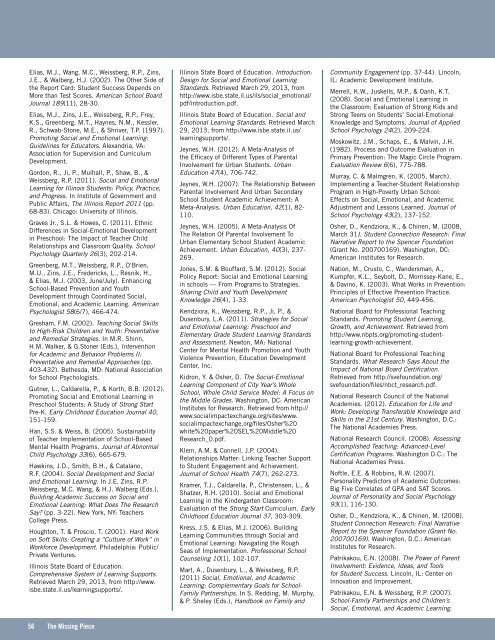the-missing-piece
the-missing-piece
the-missing-piece
Create successful ePaper yourself
Turn your PDF publications into a flip-book with our unique Google optimized e-Paper software.
Elias, M.J., Wang, M.C., Weissberg, R.P., Zins,J.E., & Walberg, H.J. (2002). The O<strong>the</strong>r Side of<strong>the</strong> Report Card: Student Success Depends onMore than Test Scores. American School BoardJournal 189(11), 28-30.Elias, M.J., Zins, J.E., Weissberg, R.P., Frey,K.S., Greenberg, M.T., Haynes, N.M., Kessler,R., Schwab-Stone, M.E., & Shriver, T.P. (1997).Promoting Social and Emotional Learning:Guidelines for Educators. Alexandria, VA:Association for Supervision and CurriculumDevelopment.Gordon, R., Ji, P., Mulhall, P., Shaw, B., &Weissberg, R.P. (2011). Social and EmotionalLearning for Illinois Students: Policy, Practice,and Progress. In Institute of Government andPublic Affairs, The Illinois Report 2011 (pp.68-83). Chicago: University of Illinois.Graves Jr., S.L. & Howes, C. (2011). EthnicDifferences in Social-Emotional Developmentin Preschool: The Impact of Teacher ChildRelationships and Classroom Quality. SchoolPsychology Quarterly 26(3), 202-214.Greenberg, M.T., Weissberg, R.P., O’Brien,M.U., Zins, J.E., Fredericks, L., Resnik, H.,& Elias, M.J. (2003, June/July). EnhancingSchool-Based Prevention and YouthDevelopment through Coordinated Social,Emotional, and Academic Learning. AmericanPsychologist 58(6/7), 466-474.Gresham, F.M. (2002). Teaching Social Skillsto High-Risk Children and Youth: Preventativeand Remedial Strategies. In M.R. Shinn,H.M. Walker, & G.Stoner (Eds.), Interventionfor Academic and Behavior Problems II:Preventative and Remedial Approaches (pp.403-432). Be<strong>the</strong>sda, MD: National Associationfor School Psychologists.Gutner, L., Caldarella, P., & Korth, B.B. (2012).Promoting Social and Emotional Learning inPreschool Students: A Study of Strong StartPre-K. Early Childhood Education Journal 40,151-159.Han, S.S. & Weiss, B. (2005). Sustainabilityof Teacher Implementation of School-BasedMental Health Programs. Journal of AbnormalChild Psychology 33(6), 665-679.Hawkins, J.D., Smith, B.H., & Catalano,R.F. (2004). Social Development and Socialand Emotional Learning. In J.E. Zins, R.P.Weissberg, M.C. Wang, & H.J. Walberg (Eds.),Building Academic Success on Social andEmotional Learning: What Does The ResearchSay? (pp. 3-22). New York, NY: TeachersCollege Press.Houghton, T. & Proscio, T. (2001). Hard Workon Soft Skills: Creating a “Culture of Work” inWorkforce Development. Philadelphia: Public/Private Ventures.Illinois State Board of Education.Comprehensive System of Learning Supports.Retrieved March 29, 2013, from http://www.isbe.state.il.us/learningsupports/.56 The Missing PieceIllinois State Board of Education. Introduction:Design for Social and Emotional LearningStandards. Retrieved March 29, 2013, fromhttp://www.isbe.state.il.us/ils/social_emotional/pdf/introduction.pdf.Illinois State Board of Education. Social andEmotional Learning Standards. Retrieved March29, 2013, from http://www.isbe.state.il.us/learningsupports/.Jeynes, W.H. (2012). A Meta-Analysis of<strong>the</strong> Efficacy of Different Types of ParentalInvolvement for Urban Students. UrbanEducation 47(4), 706-742.Jeynes, W.H. (2007). The Relationship BetweenParental Involvement And Urban SecondarySchool Student Academic Achievement: AMeta-Analysis. Urban Education, 42(1), 82-110.Jeynes, W.H. (2005). A Meta-Analysis OfThe Relation Of Parental Involvement ToUrban Elementary School Student AcademicAchievement. Urban Education, 40(3), 237-269.Jones, S.M. & Bouffard, S.M. (2012). SocialPolicy Report: Social and Emotional Learningin schools — From Programs to Strategies.Sharing Child and Youth DevelopmentKnowledge 26(4), 1-33.Kendziora, K., Weissberg, R.P., Ji, P., &Dusenbury, L.A. (2011). Strategies for Socialand Emotional Learning: Preschool andElementary Grade Student Learning Standardsand Assessment. Newton, MA: NationalCenter for Mental Health Promotion and YouthViolence Prevention, Education DevelopmentCenter, Inc.Kidron, Y. & Osher, D. The Social-EmotionalLearning Component of City Year’s WholeSchool, Whole Child Service Model: A Focus on<strong>the</strong> Middle Grades. Washington, DC: AmericanInstitutes for Research. Retrieved from http://www.socialimpactexchange.org/sites/www.socialimpactexchange.org/files/Osher%20white%20paper%20SEL%20Middle%20Research_0.pdf.Klem, A.M. & Connell, J.P. (2004).Relationships Matter: Linking Teacher Supportto Student Engagement and Achievement.Journal of School Health 74(7), 262-273.Kramer, T.J., Caldarella, P., Christensen, L., &Shatzer, R.H. (2010). Social and EmotionalLearning in <strong>the</strong> Kindergarten Classroom:Evaluation of <strong>the</strong> Strong Start Curriculum. EarlyChildhood Education Journal 37, 303-309.Kress, J.S. & Elias, M.J. (2006). BuildingLearning Communities through Social andEmotional Learning: Navigating <strong>the</strong> RoughSeas of Implementation. Professional SchoolCounseling 10(1), 102-107.Mart, A., Dusenbury, L., & Weissberg, R.P.(2011) Social, Emotional, and AcademicLearning: Complementary Goals for School-Family Partnerships. In S. Redding, M. Murphy,& P. Sheley (Eds.), Handbook on Family andCommunity Engagement (pp. 37-44). Lincoln,IL: Academic Development Institute.Merrell, K.W., Juskells, M.P., & Oanh, K.T.(2008). Social and Emotional Learning in<strong>the</strong> Classroom: Evaluation of Strong Kids andStrong Teens on Students’ Social-EmotionalKnowledge and Symptoms. Journal of AppliedSchool Psychology 24(2), 209-224.Moskowitz, J.M., Schaps, E., & Malvin, J.H.(1982). Process and Outcome Evaluation inPrimary Prevention: The Magic Circle Program.Evaluation Review 6(6), 775-788.Murray, C. & Malmgren, K. (2005, March).Implementing a Teacher-Student RelationshipProgram in High-Poverty Urban School:Effects on Social, Emotional, and AcademicAdjustment and Lessons Learned. Journal ofSchool Psychology 43(2), 137-152.Osher, D., Kendziora, K., & Chinen, M. (2008,March 31). Student Connection Research: FinalNarrative Report to <strong>the</strong> Spencer Foundation(Grant No. 200700169). Washington, DC:American Institutes for Research.Nation, M., Crusto, C., Wandersman, A.,Kumpfer, K.L., Seybolt, D., Morrissey-Kane, E.,& Davino, K. (2003). What Works in Prevention:Principles of Effective Prevention Practice.American Psychologist 50, 449-456.National Board for Professional TeachingStandards. Promoting Student Learning,Growth, and Achievement. Retrieved fromhttp://www.nbpts.org/promoting-studentlearning-growth-achievement.National Board for Professional TeachingStandards. What Research Says About <strong>the</strong>Impact of National Board Certification.Retrieved from http://svefoundation.org/svefoundation/files/nbct_research.pdf.National Research Council of <strong>the</strong> NationalAcademies. (2012). Education for Life andWork: Developing Transferable Knowledge andSkills in <strong>the</strong> 21st Century. Washington, D.C.:The National Academies Press.National Research Council. (2008). AssessingAccomplished Teaching: Advanced-LevelCertification Programs. Washington D.C.: TheNational Academies Press.Noftle, E.E. & Robbins, R.W. (2007).Personality Predictors of Academic Outcomes:Big Five Correlates of GPA and SAT Scores.Journal of Personality and Social Psychology93(1), 116-130.Osher, D., Kendziora, K., & Chinen, M. (2008).Student Connection Research: Final NarrativeReport to <strong>the</strong> Spencer Foundation (Grant No.200700169). Washington, D.C.: AmericanInstitutes for Research.Patrikakou, E.N. (2008). The Power of ParentInvolvement: Evidence, Ideas, and Toolsfor Student Success. Lincoln, IL: Center onInnovation and Improvement.Patrikakou, E.N. & Weissberg, R.P. (2007).School-Family Partnerships and Children’sSocial, Emotional, and Academic Learning.


